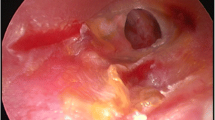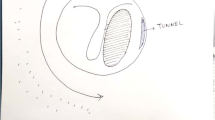Abstract
To study and compare the outcomes of the endoscopic versus microscopic approach to Myringoplasty in 60 patients. In this prospective study, the outcomes of 60 ears of 60 patients (40 male and 20 female) who underwent Myringoplasty were evaluated. The age range of the patients was 15–55 years. Group 1 underwent Myringoplasty with an endoscopic technique (n = 30), and Group 2 underwent Myringoplasty with the conventional microscopic technique (n = 30). A temporalis fascia graft was used in both groups. The outcomes were analyzed in terms of the hearing gain, duration of surgery, graft success rate and advantages and disadvantages of endoscopic versus microscopic approach to Myringoplasty. In both groups, the postoperative air-bone gap (ABG) was significantly lower than the preoperative ABG. There were no significant differences between the preoperative and postoperative ABG values (in dB) in either group. The mean operative duration in Group 1 (96.32 min) was significantly lower than that in Group 2 (136.09 min). In the preoperative evaluation of patients in Group 1 had small, medium, large perforations are 16 (53 %), 12 (40 %), and 02 (7 %), respectively. In Group 2, had small, medium, large perforations are 12 (40 %), 15 (50 %), and 03 (10 %), respectively. Perforations (wet ear) were detected in 10 (33 %), 06 (20 %), and 04 (12 %) of the patients in Group 1 at postoperative months 1, 3, and 6, respectively. Perforations (wet ear) were detected 09 (30 %), 06 (20 %) and 03 (10 %) patients in Group 2 at postoperative months 1, 3, and 6. At 6 months postoperatively, there were smaller perforations and reduced rate of perforations as compared to 1st and 3rd month in Group 1 and Group 2. The difference between the perforation conditions (larger vs. smaller) was not significant in either group. The preoperative and postoperative increases in the ABG were associated. At the end of 6 months all (100 %) patients in the Group 1 rated their cosmetic result as excellent as compared in the Group 2. Unlike the microscope, the endoscope is easily transportable and hence is ideal for use in ear surgery camps conducted in remote places. In patients undergoing Myringoplasty, especially if the external ear canal is narrow and the anterior canal wall is prominent, the endoscopic and microscopic approaches appear to give equal results in terms of easy visualization of the entire tympanic membrane and no requirement for extra intervention to evaluate the ossicular system. A shorter operative duration and excellent cosmetic result is an advantage of the endoscopic Myringoplasty technique.



Similar content being viewed by others
References
Tarabichi M (1999) Endoscopic middle ear surgery. Ann Otol Rhinol Laryngol 108:39–46
Glasscock ME (1973) Tympanic membrane grafting with fascia; overlay vs. undersurface technique. Laryngoscope 83(5):754–770
Wullstein H (1956) The restoration of the function of the middle ear, in chronic otitis media. Ann Otol Rhinol Laryngol 65:1020–1041
Raj A, Meher R (2001) Endoscopic transcanal myringoplasty—a study. Indian J Otolaryngol Head Neck Surg 53(1):47–49
Wullstien H (1953) Technic and early results of tympanoplasty. Monatsschr Ohrenheilkd Laryngorhinol 87(4):308–311
Raj A, Meher R (2001) Endoscopic transcanal myringoplasty—a study. Indian J Otolaryngol Head Neck Surg 53:47–49
Mohindra S, Panda NK (2010) Ear surgery without microscope; is it possible. Indian J Otolaryngol Head Neck Surg 62(2):138–141
El-Guindy A (1992) Endoscopic transcanal myringoplasty. J Laryngol Otol 106:493–495
Usami S, Iijima N, Fujita S et al (2001) Endoscope-assisted myringoplasty. Otorhinolaryngology 63:287–290
Patil RN (2003) Endoscopic tympanoplasty—definitely advantageous (preliminary reports). Asian J Ear Nose Throat 25:9–13
Rosenberg SI (1996) Endoscopic otologic surgery. Otolaryngol Clin North Am 29:291–300
Karhuketo TS, Ilomaki JH, Puhakka HJ (2001) Tympanoscope-assisted myringoplasty. Otorhinolaryngology 63:353–358
Jadav SP et al (2009) Endoscope assisted myringoplasty. Singap Med J 50(5):510
Author information
Authors and Affiliations
Corresponding author
Ethics declarations
Conflict of interest
The authors of this article declare that he/she has no conflict of interest.
Human and Animal Rights
Animals were not involved in this study.
Ethical Approval
All procedures performed in studies involving human participants were in accordance with the ethical standards of the institutional and with the 1964 Helsinki declaration and its later amendments or comparable ethical standards.
Informed Consent
Informed consent was obtained from all individual participants included in the study.
Rights and permissions
About this article
Cite this article
Lakpathi, G., Sudarshan Reddy, L. & Anand Comparative Study of Endoscope Assisted Myringoplasty and Microscopic Myringoplasty. Indian J Otolaryngol Head Neck Surg 68, 185–190 (2016). https://doi.org/10.1007/s12070-016-0970-8
Received:
Accepted:
Published:
Issue Date:
DOI: https://doi.org/10.1007/s12070-016-0970-8




